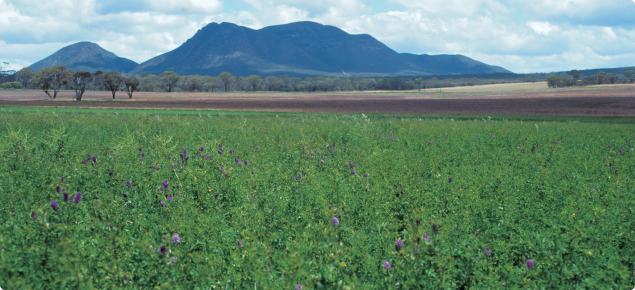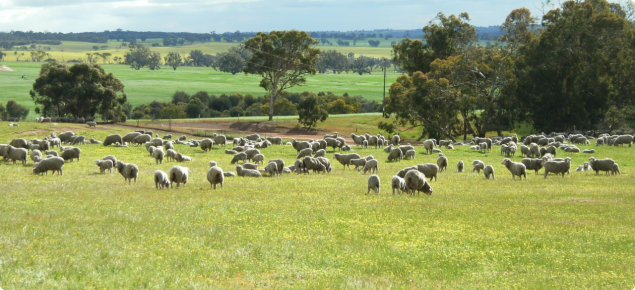Building the soil carbon sponge at Murray Wells, Tambellup, Western Australia

Peter and Wendy Bradshaw's farm is 25 km west of Tambellup in the Great Southern region of Western Australia, with an annual rainfall of 450 mm. They produce wool, prime lambs, oats and barley. Normally, around 70% of the farm is under pasture each year.
Peter and Wendy, driven by a desire to produce healthy food and minimise harm to the natural environment, have trialled and adopted a wide range of regenerative farming practices. Many of these practices are established ‘good farming’ practices used throughout the Great Southern.
Practices used on the farm to protect soil biological function and farm profitability include:
- perennial pastures
- multi-species cover crops
- min-till seeding operation using disc openers
- minimising the use of pesticides and synthetic fertilisers
- managing pastures to maximise ground cover
- biodiverse shelterbelts
- protecting and buffering creek-lines.
Peter and Wendy have a strong focus on the relationship between soil health and plant nutrition. They test their soil regularly and design their nutritional inputs to overcome key limitations to productivity – allowing the soil biology to do the heavy lifting. They supplement nutritional inputs with humic/fulvic acid, compost extract, liquid fish and other bio-stimulants, to maintain and enhance a diverse and thriving soil microbiome.
‘Our lifestyle and wellbeing has dramatically improved as a result of practicing regenerative agriculture, an approach to farming that aligns with our value framework. Economically it has been challenging, with many ups and downs. It is important to immerse yourself and be constantly questioning whether you are addressing the key limitations to making the system work. It is not easy – but it is exciting! It is a constant journey of discovery involving collaboration with others for mutual learning’.
To read more about what they have done download Building the soil carbon sponge at Murray Wells farm, Tambellup, Western Australia
Rehydrating the landscape at Yanget, Geraldton, Western Australia
Rod and Bridie O’Bree’s farm is 25 kms east of Geraldton in the Northern Agricultural region of Western Australia. They run a 150 head beef cattle herd, fatten 500–700 lambs annually and have a 40–60 head horse stud on the farm. The long-term rainfall average is 486 mm, although that has dropped to 354 mm over the last 30 years.
Rod and Bridie purchased the farm early in 2008 after one of the worst droughts in the area. There was little to no vegetation, brown or green, across the farm, and all of the water from a 25 mm rainfall ran off the farm through the creek lines taking valuable soil with it. The O’Brees felt they could do better and set about learning and trialling how to manage the farm sustainably.
The O’Brees aimed to hold as much water on the farm as possible using the broad natural sequence farming approach. This included earthworks to hold water up and then spread it out across paddocks. They established perennial pastures to use the water and allowing a wide diversity of annual plants to establish in the paddocks.
Water now moves slowly through the farm with little or no water leaving the property in creek lines. Groundcover has increased and erosion has significantly reduced. Pastures are much more diverse now, and this keeps stock healthy and happy. Creeklines have regenerated naturally with native species. Grazing capacity has increased.
To read more about what they have done download Rehydrating the landscape at Yanget, Geraldton, Western Australia.
Building the soil and the community at Hollands Track Farm, Newdegate, Western Australia
The Kelly family have been farming at Hollands Track Farm, about 18 kms south west of Newdegate, since 1965 when Malcolm and Cathie Kelly moved from Meckering and started clearing the property. They produce grains, beef, eggs and sheep. Long term annual average rainfall is 350 mm. The Kelly’s son Nick and his wife Lucy now farm in partnership with Malcolm and Cathie.
The Kellys were early adopters – in the 1990s – of the no-till farming system, which is now widely used in Western Australia. Around 2002 they sold the last of their sheep and moved to a continuous cropping program with increased fertiliser and chemical use. The Kellys were very good at this system and it served them well. Malcolm and Nick both really enjoy the challenge of growing good crops.
Over time, persistent weeds emerged on the farm and these – along with other constraints including soil compaction, low pH and decreasing nutrient and carbon levels – led Nick to investigate ways to solve these problems.
The Kellys developed a series of soil care principles to guide their farm management. These principles are founded in nature, as observed by Nick:
- maintain groundcover
- minimise soil disturbance
- keep living plants with roots in the soil for as much of the year as possible
- encourage diversity – no monocultures
- integrate animals
- reduce or eliminate synthetics.
These principles are all aimed at increasing biodiversity above and below the ground to produce nutrient-dense food that is free from pesticide residues. They are based on the knowledge that biodiversity enables efficient nutrient cycling, carbon sequestration through plant root exudates and biomass breakdown, improved water infiltration through soil aggregates, and increased water-holding capacity. The Kellys have trialled and adopted a wide range of new practices to enable them to achieve their goals.
To read more about what they have done download Building the soil and the community at Hollands Track Farm, Newdegate, Western Australia.
Managing dryland salinity - case studies
Some of the practices used to manage salinity in Western Australia are regenerative in nature. Practices such as the use of perennial pastures, fodder shrubs such as saltbush and grazing with livestock can contribute to overall soil health and improve production on saline areas. DPIRD and other organisations have documented a number of case studies of salinity management. These case studies may be useful to farmers considering options to use saline land.


